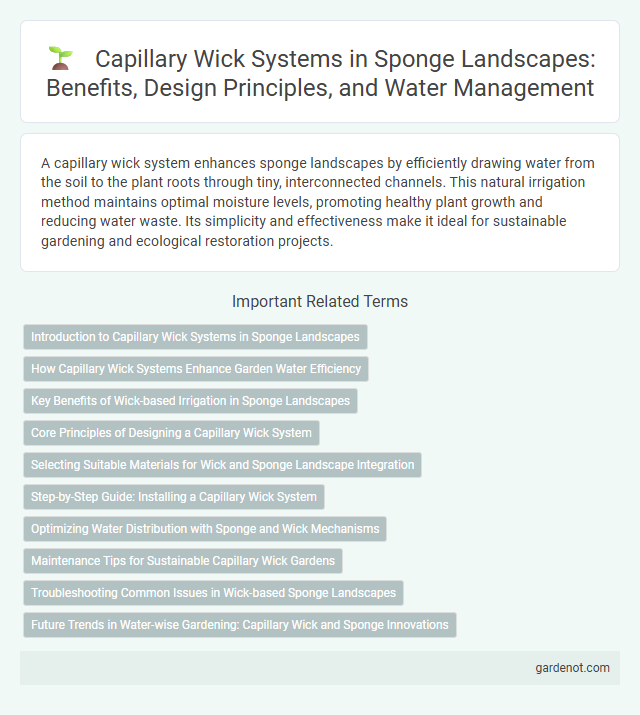A capillary wick system enhances sponge landscapes by efficiently drawing water from the soil to the plant roots through tiny, interconnected channels. This natural irrigation method maintains optimal moisture levels, promoting healthy plant growth and reducing water waste. Its simplicity and effectiveness make it ideal for sustainable gardening and ecological restoration projects.
Introduction to Capillary Wick Systems in Sponge Landscapes
Capillary wick systems in sponge landscapes utilize the principle of capillary action to efficiently distribute water throughout porous soil or bio-retention media, enhancing moisture retention and plant hydration. These systems involve hydrophilic materials, such as fabric or rope wicks, which draw water from reservoirs or saturated zones, ensuring consistent moisture availability even during dry periods. By optimizing water delivery at the root zone, capillary wick systems contribute to sustainable urban drainage and resilient landscape management.
How Capillary Wick Systems Enhance Garden Water Efficiency
Capillary wick systems enhance garden water efficiency by delivering a steady, controlled flow of moisture directly to plant roots, minimizing water waste through evaporation and runoff. These systems utilize porous materials that draw water upward via capillary action, maintaining consistent soil hydration even in dry conditions. By ensuring precise water distribution, capillary wick systems promote healthier plant growth and reduce overall irrigation needs.
Key Benefits of Wick-based Irrigation in Sponge Landscapes
The capillary wick system in sponge landscapes ensures consistent soil moisture by delivering water directly to plant roots, minimizing evaporation and runoff. This efficient irrigation method enhances water retention and supports plant health during dry periods. Reduced water waste and improved drought resilience contribute to sustainable urban green spaces.
Core Principles of Designing a Capillary Wick System
A capillary wick system relies on the fundamental principle of capillary action, where liquids move through narrow spaces without external forces, driven by surface tension between liquid and solid materials. Designing an effective wick involves selecting porous materials with optimal pore size and distribution to maximize fluid transport and retention while preventing flow blockage. Precise control of wick geometry and material hydrophilicity ensures consistent moisture delivery, critical for maintaining sponge landscape health and efficiency.
Selecting Suitable Materials for Wick and Sponge Landscape Integration
Selecting suitable materials for the capillary wick system in sponge landscape integration involves prioritizing high porosity and water retention capacity to ensure efficient moisture distribution. Natural fibers like cotton or hemp combined with synthetic materials such as nylon provide durability and optimal capillary action, supporting sustainable plant hydration. Compatibility with the surrounding substrate enhances the overall system's effectiveness, promoting healthy root development and consistent water supply.
Step-by-Step Guide: Installing a Capillary Wick System
Installing a capillary wick system in a sponge landscape begins by selecting an appropriate wick material such as cotton or synthetic fibers with high water absorption properties. Lay the wick evenly within the soil, ensuring it maintains contact with both the water reservoir below and the root zone above for efficient capillary action. Secure the wick and monitor moisture levels regularly to optimize water distribution and promote healthy plant growth in the sponge landscape environment.
Optimizing Water Distribution with Sponge and Wick Mechanisms
The capillary wick system enhances water distribution by leveraging the porous structure of sponges to draw and evenly disperse moisture through capillary action. This mechanism ensures consistent hydration by allowing water to travel against gravity, maintaining optimal soil moisture levels for plant health. Integrating sponge materials with wick technology maximizes water retention and reduces irrigation frequency, promoting sustainable landscape management.
Maintenance Tips for Sustainable Capillary Wick Gardens
Regularly inspect the capillary wick system for blockages or mineral buildup to ensure consistent water flow in sponge landscape gardens. Use filtered water to minimize debris accumulation and gently clean the wicks with a soft brush or diluted vinegar solution to maintain optimal moisture retention. Periodic replacement of worn or degraded wick materials supports the sustainability and efficiency of capillary wick gardens.
Troubleshooting Common Issues in Wick-based Sponge Landscapes
Clogging of the capillary wick is a frequent issue in wick-based sponge landscapes, often caused by mineral buildup or debris obstructing water flow. Ensuring regular cleaning or replacing the wick with materials like cotton or synthetic fibers maintains optimal water distribution. Uneven moisture levels can be addressed by adjusting the wick placement or selecting appropriate wick thickness to enhance capillary action efficiency.
Future Trends in Water-wise Gardening: Capillary Wick and Sponge Innovations
Future trends in water-wise gardening emphasize advancements in capillary wick systems integrated with sponge landscape technologies to optimize soil moisture retention and reduce irrigation frequency. Innovations include enhanced hydrophilic materials that improve water distribution efficiency and smart sensors that regulate moisture levels in real-time. These developments promise sustainable gardening solutions that minimize water waste while supporting healthy plant roots in arid and drought-prone environments.
Capillary wick system Infographic

 gardenot.com
gardenot.com